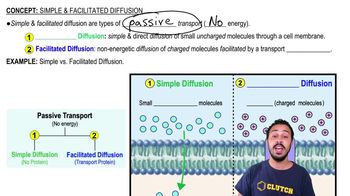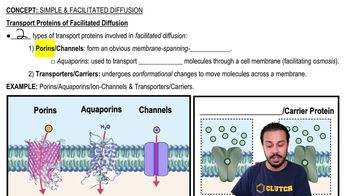Simple and Facilitated Diffusion quiz Flashcards
 Back
BackTerms in this set (29)
What are the two main types of transport proteins involved in facilitated diffusion?
The two main types of transport proteins involved in facilitated diffusion are porins (channels) and transporters (carriers).
How do porins facilitate the movement of molecules across the cell membrane?
Porins form membrane-spanning tunnels that allow molecules to move across the membrane through these tunnels.
What specific type of porin is involved in the transport of water molecules?
Aquaporins are the specific type of porins involved in the transport of water molecules, facilitating osmosis.
How do transporters or carriers differ from porins in their mechanism of transporting molecules?
Transporters or carriers do not form membrane-spanning tunnels; they are only open on one side of the membrane at a time and must undergo conformational changes to move molecules across the membrane.
What is the role of ion channels in facilitated diffusion?
Ion channels allow ions with charges, such as positive ions, to move through the membrane-spanning tunnels to the other side of the membrane.
What is the main difference between simple diffusion and facilitated diffusion?
Simple diffusion does not require transport proteins, while facilitated diffusion requires transport proteins to move molecules across the cell membrane.
What is the primary energy source for primary active transport?
The primary energy source for primary active transport is ATP hydrolysis.
How does secondary active transport differ from primary active transport?
Secondary active transport is driven by another molecule's concentration gradient, not directly by ATP hydrolysis.
What is the role of ATP in primary active transport?
ATP provides the energy needed to transport molecules against their concentration gradients in primary active transport.
What is the main function of aquaporins in the cell membrane?
Aquaporins facilitate the rapid transport of water molecules across the cell membrane, enhancing the process of osmosis.
What is the significance of conformational changes in transporter proteins?
Conformational changes in transporter proteins allow them to move molecules from one side of the membrane to the other by changing their shape.
What is the main characteristic of facilitated diffusion that distinguishes it from active transport?
Facilitated diffusion transports molecules down their concentration gradients passively without any energy input, unlike active transport which requires energy.
What type of transport protein is involved in the facilitated diffusion of ions?
Ion channels are the type of transport proteins involved in the facilitated diffusion of ions.
What is the role of concentration gradients in secondary active transport?
In secondary active transport, the movement of one molecule down its concentration gradient provides the energy to transport another molecule against its concentration gradient.
- What is the main difference between simple diffusion and facilitated diffusion?Facilitated diffusion requires a protein transporter, while simple diffusion does not.
- Does facilitated diffusion require energy?No, facilitated diffusion is a passive process and does not require energy.
- Which type of molecules typically require facilitated diffusion to cross the cell membrane?Polar or charged molecules typically require facilitated diffusion.
- Can nonpolar oxygen gas molecules pass through the cell membrane via simple diffusion?Yes, nonpolar oxygen gas molecules can pass through the cell membrane via simple diffusion.
- Why can't charged calcium ions pass through the cell membrane via simple diffusion?Charged calcium ions cannot pass through the hydrophobic core of the lipid bilayer and require facilitated diffusion.
- What role do protein channels play in facilitated diffusion?Protein channels help transport molecules that cannot pass through the cell membrane on their own.
- Does facilitated diffusion move molecules against their concentration gradient?No, facilitated diffusion moves molecules with their concentration gradient.
- What type of molecules can easily pass through the cell membrane via simple diffusion?Small, nonpolar molecules can easily pass through the cell membrane via simple diffusion.
- Why do polar molecules require facilitated diffusion?Polar molecules require facilitated diffusion because they cannot easily pass through the hydrophobic core of the lipid bilayer.
- Is energy required for molecules to move through protein channels in facilitated diffusion?No, energy is not required for molecules to move through protein channels in facilitated diffusion.
- What is a key characteristic of molecules that use simple diffusion?Molecules that use simple diffusion are typically small and nonpolar.
- Why is facilitated diffusion considered a type of passive transport?Facilitated diffusion is considered passive transport because it does not require energy.
- Can nonpolar carbon dioxide gas molecules pass through the cell membrane via simple diffusion?Yes, nonpolar carbon dioxide gas molecules can pass through the cell membrane via simple diffusion.
- What is the role of the lipid bilayer in simple diffusion?The lipid bilayer allows small, nonpolar molecules to pass through via simple diffusion.
- Why do charged sodium ions require facilitated diffusion?Charged sodium ions require facilitated diffusion because they cannot pass through the hydrophobic core of the lipid bilayer.


